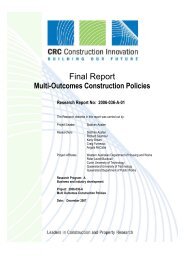A Practical Guide to Safety Leadership Book (PDF 5MB) - QUT ePrints
A Practical Guide to Safety Leadership Book (PDF 5MB) - QUT ePrints
A Practical Guide to Safety Leadership Book (PDF 5MB) - QUT ePrints
You also want an ePaper? Increase the reach of your titles
YUMPU automatically turns print PDFs into web optimized ePapers that Google loves.
Appendix<br />
this initial exercise, it was determined that 10 existing training courses already satisfied several requirements specified in the<br />
competency framework, and that a further three distinct training modules were needed <strong>to</strong> deliver on all the remaining competencies<br />
specified within the competency framework.<br />
The competency framework, however, is not just about training. It is also about developing strategies that drive desirable behaviours<br />
and enable individuals <strong>to</strong> develop competencies that are not necessarily acquired through traditional training methods. In this<br />
instance, the competency framework has been extremely useful in enabling the company <strong>to</strong> evaluate current competency<br />
statements, against the framework, and <strong>to</strong> further refine these <strong>to</strong> align with existing safety culture development activities.<br />
The company’s internal competency statements are then better equipped <strong>to</strong> identify necessary development activities for new<br />
staff and existing staff as part of the company’s personal development review process.<br />
Key learning<br />
The analysis of competency training needs and a ‘gap’ analysis of current and planned training benchmarked against the<br />
competency framework communicates a strong message that Baulders<strong>to</strong>ne Hornibrook is committed <strong>to</strong> safety culture<br />
development.<br />
Case study 5:<br />
St Hilliers Contracting<br />
St Hilliers Contracting developed the St Hilliers Skills Matrix, an internal competency and skills assessment framework that forms<br />
the foundation for the selection, training, development and performance management of staff.<br />
This matrix comprises nine competency clusters and includes the technical skills and interpersonal skills required for all project-based<br />
staff. It provides a <strong>to</strong>ol <strong>to</strong> measure the skills, knowledge and behaviours of construction project staff and will be incorporated in<strong>to</strong><br />
all of St Hilliers’ human resource and people management systems.<br />
A Construction <strong>Safety</strong> Competency Framework forms the basis of the environment, systems and safety competency cluster in<br />
the St Hilliers Skills Matrix.<br />
To achieve an organisational ‘fit’, St Hilliers reviewed the knowledge, skill and behaviour (KSB) statements in the competency<br />
framework by identifying and incorporating 10 common KSB’s across the 39 safety management tasks within the competency<br />
framework. These common KSB’s became the basis for the environment, systems and safety cluster in the St Hilliers’ internal<br />
competency and skills assessment framework. They can be measured by a variety of means including observation, performance<br />
data, project outcomes and knowledge assessment.<br />
In addition, the competency framework is being used <strong>to</strong> audit position descriptions and site safety management plans <strong>to</strong> ensure<br />
all appropriate safety management tasks are incorporated. This outcome will be achieved by first modifying the safety critical<br />
position titles <strong>to</strong> reflect current internal positions and then using the matrix <strong>to</strong> verify that all safety critical tasks as identified by the<br />
competency framework fall within someone’s scope of accountability, either within the position descriptions or the site safety<br />
management plans. It is proving <strong>to</strong> be a very useful <strong>to</strong>ol in differentiating the levels of responsibility and competence required of<br />
their employees. These two steps are a simple and meaningful way for companies <strong>to</strong> incorporate the competency framework in<br />
<strong>to</strong> daily business.<br />
Key learning<br />
St Hilliers developed a skills matrix with nine competency clusters. By incorporating an environment, systems and safety<br />
competency cluster, it demonstrated a practical solution <strong>to</strong> embedding the OH&S required competencies in the regular<br />
human resources practices of the organisation. This process clearly indicates that St Hilliers values safety behaviour and<br />
culture as importantly as other human and environmental resource issues.<br />
30 A <strong>Practical</strong> <strong>Guide</strong> <strong>to</strong> <strong>Safety</strong> <strong>Leadership</strong>: Implementing A Construction <strong>Safety</strong> Competency Framework

















